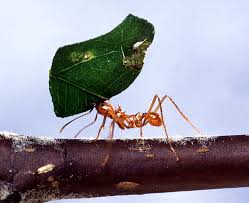For all of modern humanity’s technological prowess, the best chemistry lab on the planet is arguably still owned by mother nature. On Tuesday, Tim McDonnell at Mother Jones spotted work by researchers at the University of Wisconsin-Madison, among others, that may lead to a powerful new enzyme for producing cellulosic biofuels. And they did this by studying, of all things, leafcutter ants.
The thing about cellulosic biofuels is they’re produced from grass, wood chips, or other feed stocks that don’t double as food. More traditional biofuels, since they’re most often produced from corn, impinge on the food supply. The spike in corn demand — and thus the spike in corn price — that’s been fueled by America and European biofuel policies has arguably wrecked the food security of millions of poor people in developing countries around the world. And that’s on top the rising global food crisis from droughts and extreme weather driven by climate change.
But cellulosic biofuels remain an up-and-coming technology, with a commercial viability that’s far from certain. So big breaks in designing the enzymes and chemical processes is a big deal.
What Frank Aylward and his fellow researchers did was go down to Panama and Costa Rica to study how leafcutter ants produce their food. The insects literally cultivate a fungus in their underground nests that breaks down the bits of leaves they bring back. (The ants can collect half the weight of a cow in leaf material per colony every year.) Aylward and co. were able to isolate and identify the enzyme the fungus uses for this process, and realized it could be a powerful tool for biofuel production. As they told Mother Jones, the enzyme could even make biofuel out of the other parts of the corn stalk that don’t serve as food for humans:
For making fuel, Aylward asks, “why don’t we use the rest of the corn plant? It’s because the sugars are tied up in cellulose and other things that are hard to break down. So we’re looking for enzymes that can help.” Enzymes are already used for this purpose, and a crop of businesses have sprung up in the biofuel boom to manufacture them, but Aylward believes his could be among the most efficient ever discovered. And using every part of the corn plant, including parts that typically go to waste, could make ethanol production more sustainable and boost its climate benefits.
Obviously, if we can crack the chemistry for turning the rest of the corn stalk into biofuel, while leaving the cob itself as food, that might largely circumvent the food security problem. Beyond that, even the feedstocks for cellulosic biofuels have to be grown on cropland. That encourages deforestation, and as far as the simple math of carbon budgets go, naturally occurring forests and grasslands remove more carbon from the atmosphere than cropland. But if we can create cellulosic biofuel from land that’s already being used to grow food anyway, that could massively improve the quality of our land use.
Granted, biofuels are probably never going to be the biggest part of a renewable energy economy. But they will be a part, and this will be an exciting development if it pans out. Aylward told Mother Jones he’s already been approached by private firms interested in manufacturing the enzyme and starting work on biofuel production, so here’s to hoping.
This article was originally published on Climate Progress. Reproduced with permission










